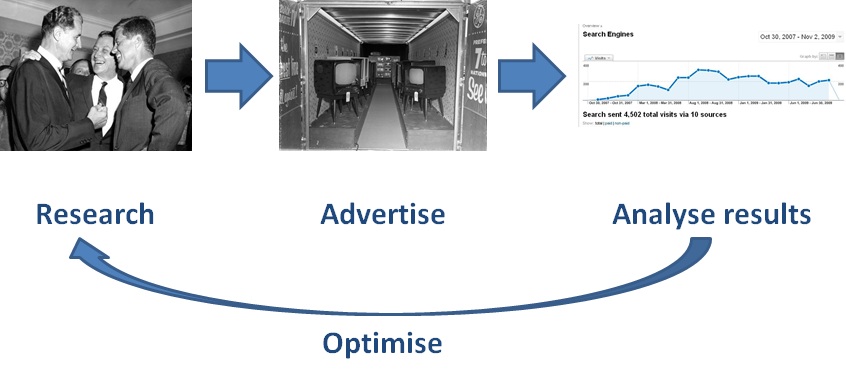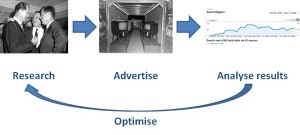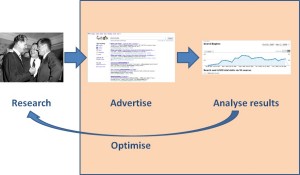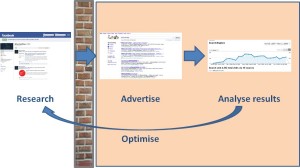Social Media Integration with Web Analytics: How, Why, What

We’ve been talking about social media in the office quite a lot recently. And why not, it is not just starting to take off in the sense that people are using it, but that Marketers are wondering how they make use of it all. As we have been discussing that this is going to be the start of Marketers seeing social media platforms as being vital for the advertising of their products.
However, as Google Analytics built a bridge between site analytics and advertising analytics for those doing Search Marketing, there is going to be a growing trend of Analytics bridging the gap between site analytics and social media analytics. So here I am going to explain why it is a good idea, how you do it (roughly) and then what you need to do at the end of it all. But before we can do that, we are going to have a brief history lesson:
Old School Marketing
Back in the day (and in fact, still today) offline Marketing has been a big mystery. William Lever once said “I know half of my Marketing isn’t working, I just don’t know which half.” This is kind of true for most offline Marketing measuring.
What essentially happens is that there is some research done by asking people what they think (about the product, advertising, etc). When people talk about research, effectively what they are trying to do is work out what people are talking about in the real world relating to your product/brand/subject.
This will help inform the advertising type, message, timing, channel, etc to make sure that it is pushed towards the correct demographic. This stuff is sophisticated and is the reason that you’ll get adverts for cars and computer games during the Champions league semi final tomorrow, but you won’t see them during the Pop Idol final.
Someone with a degree in Statistics will then analyse the results of the campaign (whether they are sales results, brand awareness ratings, etc) to look for minor fluctuations caused by the advertising. They’ll then be able to give you an ROI for the campaign. This will lead you to try and come up with ways of optimising it, leading you to go back to the research stage again.
Don’t let anyone in the online industry pretend that in the offline world this doesn’t happen and that the offline industry is awash with people throwing money away. I sat through some excruciating meetings whilst at an insurance company listening to the offline people claim responsibility for increases in sales from the website caused by the television adverts – proven by what appeared to be minute changes in weekly sales cycles.
The emergence of online Marketing
In the new world of online Marketing it is of course much easier to do your analysing. Instead of having a statistics degree, you can now track your campaigns in a much more orderly fashion using Analytics tools. Google Analytics was one of the first who linked all of their data from their advertising directly to the data from the people using the website, but others were using campaign codes in the meantime.
So in the new world you could do so much more in one system. You can directly measure the impact of the advertising into minute detail using your analytics. No longer is it true that you don’t know which half of your advertising is wasted, because you can see which half.
This doesn’t remove from the fact that you still need to do research. Largely this research tends to be completely disassociated from your site analytics (however you can do voice of the customer integrations in SiteCatalyst). You still need to find out what they are talking about to help you build your campaigns in Google; where to put your banner adverts; who to build affiliate deals with, etc. It’s a step that is a bit too frequently left out online.
An Online Social Web
In the social world, those people doing the talking about your product/brand are now doing it online. They’re talking about you on your Facebook page, on other people’s facebook pages, on your Twitter, on other people’s Twitter, on your social media platform of choice by you and by others too.
At the moment there tends to be a giant wall between your research of what people are saying about you on Facebook (plus what their demographics are: age, sex, occupation, followers, friends, etc). Information is coming out of those systems, but you haven’t done that clever bit of linking it into your analytics. You have a load more information about your users but you can’t link them together.
It’s annoying, because that information is online. Your website is online. Why can’t you tell if they are the same people?
Breaking the Social Media Wall
What we need to do is break down that wall and start linking the data sources. However the word of caution should start here – it is really difficult to link two data sources together and not end up with loose ends. Two sets of data sources never match up in the online world. It’s the reasons that your clickthroughs and your visits for a paid search keyword may not match in Google Analytics. It’s the reason that ComScore claims you have half the visits that you think you did.
There are a few of ways you can do this:
- You can build campaign codes into the links that you deliberately put into the social world yourself. This means you should get more accurate information on the clicks into your site from those sources. This is by far the basic level that you should definitely do.
- One of the advantages of the Facebooks, Twitters, YouTubes of this world is that they build really nice APIs that allow you to transfer data from their system into yours. Great hey? Using those APIs you can transfer a host of information about what people are doing and talking about. You won’t be able to link that directly (think correlation and causation), but you will be able to have the data sources side by side (assuming your analytics tool allows data insertion – if not you might need a third party system!).
- With the more bespoke elements of Facebook and YouTube allow you to create your own ‘channel’ or page. These allow you to put custom javascript tracking code on the pages and will allow you to build your own analytics. Combining this with the results from the API for these tools will give you far more detailed demographic data about your users than you ever dared to imagine.
Credit for Pictures:
State Library and Archives of Florida
The Library of Virginia




Leave a Reply